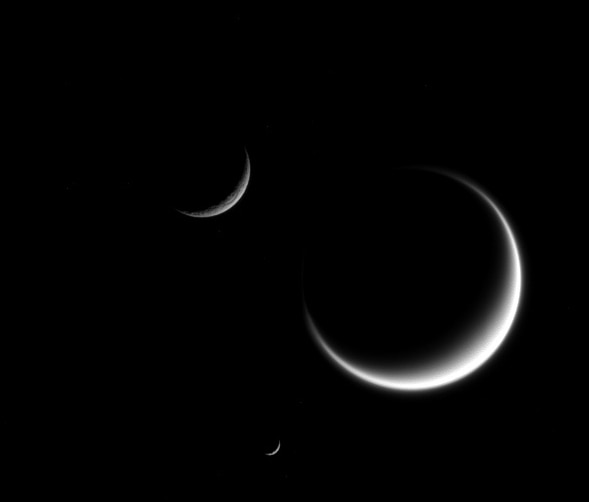Create a free profile to get unlimited access to exclusive videos, sweepstakes, and more!
Like a Sci-Fi Sunset: Three Crescent Moons Over Saturn

Every time I think I’ve seen the most amazing picture from the Cassini Saturn probe, it sends back something even more devastatingly spectacular.
Like this shot of three crescent moons huddled in the black sky!
Are you kidding me?
Wow. This image was taken on March 25, 2015. The big one is Titan, the one to the upper left is Rhea, and the little one is Mimas. Titan has a thick atmosphere, thicker than Earth’s, composed mostly of nitrogen (also like Earth’s). Sunlight hitting that air gets bent around, sent around the limb, so the crescent appears to wrap farther around the moon than it would otherwise. Mimas and Rhea are airless, so their crescents look much like the familiar one we see every month from our own Moon.
All of Saturn’s big moons orbit the planet almost exactly above its equator, so when the spacecraft’s orbit crosses that plane, the moons can appear to be close together due to perspective even when they’re hundreds of thousands of kilometers apart. The Sun is just off to the lower right in this shot, setting up the correct angles to get this spectacular and breathtaking scene.
Seriously, this looks like it came right out of a sci-fi movie. But it’s real. Those are worlds, real actual places, ones we can explore and understand.
And we have: Titan has a methane cycle on it much like Earth’s water cycle; the simple molecule can be found in clouds over the surface that rain it out as a liquid, forming rivers and giant lakes, where it evaporates to form clouds once again.
Mimas has a gigantic single crater named Herschel that makes it look like the Death Star. Though it was almost more like Alderaan: Had the impact that formed Herschel been much larger, it would’ve shattered the moon.
Rhea has deep canyons covering one hemisphere, giving it a wispy fairy-tale look, but they are actually the walls of steep canyons caused by deep fractures in the surface.
I love science fiction. It’s inspired me over the years, given me a glimpse into places we can only imagine.
But I love science more. It shows us these places as they actually are, and reminds us that clearly, Nature is far, far more imaginative than we are.














